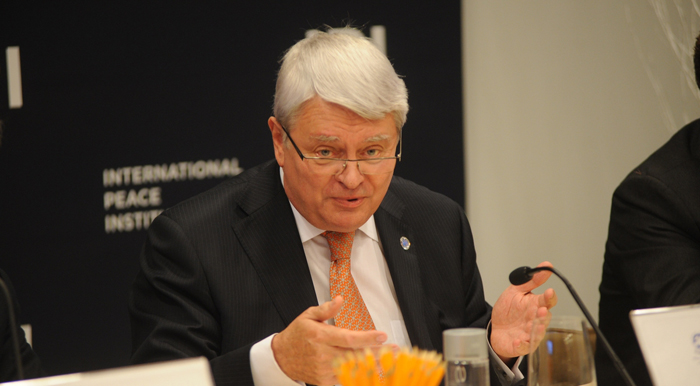
“Good news is seldom news at all,” said Hervé Ladsous, Under-Secretary-General for Peacekeeping Operations, on November 30, 2012 at an IPI event entitled “Telling the Peacekeeping Story Better.” The event was co-hosted by IPI and the Permanent Missions to the UN of Italy and Morocco.
“Media [and] public opinions are first interested in dramatic stories, in war,” he said. “More often than not, peacekeeping starts when war is over.”
Nevertheless, he added, “There are certainly ways of improving our public communication.” Mr. Ladsous’s comments came during a panel discussion that featured prominent media figures and UN officials on how to convey peacekeeping stories from the field to the broader public.
“I respect the role of the press, and in fact, if I do take something from this… it is fresh ideas,” he said. These ideas include putting more material on YouTube and having more internal meetings with the press corps. “It’s a process, and we have to encourage it,” he said.
Mr. Ladsous pointed out that noble peacekeeping endeavors often go unnoticed. For example, when he went to the Democratic Republic of the Congo (DRC) in the winter of 2011, Mr. Ladsous said he witnessed 80 peacekeepers protecting 1,500 civilians in a remote village. Criminals were trafficking minerals back and forth, killing and raping villagers along the way. “But that has little media value,” he added.
On the negative press surrounding the United Nations Organization Stabilization Mission in the DRC (MONUSCO) and its inaction during the fall of Goma, Mr. Ladsous explained that MONUSCO was not mandated to fight M23 rebels directly and risk bloodshed. However, he said, MONUSCO does conduct 84 patrols around the clock to prevent looting, rapes, and kidnappings. Mr. Ladsous argued that such actions are overlooked by the press.
To address the issue of underreporting, Peter Launsky-Tieffenthal, Under-Secretary-General for Communications and Public Information, suggested that journalists report on peacekeeping operations throughout the year, and not just during conflicts.
“It might be a story about a Swedish policewoman working to combat sexual violence in Liberia, or a Chinese engineer building roads in Haiti, or Mongolian troops repairing ambulances in South Sudan,” he said.
Raghida Dergham, Columnist and Senior Diplomatic Correspondent at Al Hayat, had a different perspective on why the stories Mr. Launsky-Tieffenthal suggested remain buried. “They’re not told because you didn’t tell it right,” she argued.
“The most important problem is that you in the United Nations have not taken the media seriously as a strategic partner when it comes to matters like this,” she said.
“This is a two-way street: you want us to do the good story and cover it? No problem, but you need to be available for the rough and tough and controversial one; it can’t be on your terms only,” she added.
Ms. Dergham, who has reported from the United Nations for over 30 years, explained that there is an inherent problem in the structure of the UN’s relationship with the media.
She referred to a 1997 task force appointed by Secretary-General Kofi Annan and headed by Mark Malloch Brown that worked for weeks to address the issue. But the document they produced disappeared, she said. “Every recommendation we made was thrown out the window.”
When asked by Ms. Dergham how many UN spokespeople there are, Mr. Launsky-Tieffenthal said, “In today’s world, with social media, every single one is a spokesperson–everyone who is out there in the field working for the United Nations in one way or the other is an eyewitness to what’s happening.”
Ms. Dergham responded, “In that case, I advise you to fire half of your [official] spokespeople… because you don’t need many of them anyway. Half of them are not useful.”
She added, “The official ones are guarding [information]. It seems that their job is to push us away.”
Colum Lynch, UN Correspondent for the Washington Post and author of the Turtle Bay blog at Foreign Policy, described the potential for reporting on interesting peacekeeping stories if there were a better partnership between the media and the UN.
“One of the things that you never hear is the voice of peacekeepers,” he said.
Young reporters would have jumped at the opportunity to go off with, for example, Indian peacekeepers who are engaged in armed conflict with the M23, he said.
The whole concept of robust peacekeeping and use of engagement in offensive operations in the past decade, going back to Sierra Leone, is a point of interest to reporters, he added.
Mr. Lynch described his feelings toward the idea of crafting a story based on UN public relations statements as a reflexive repulsion. “For us, it’s of limited use,” he said. “What I need is access to senior people who are decision makers… and I need sensitive information that they don’t want to give me.”
“If the UN is confident about these sorts of things, they need to open the door. And if they don’t open the door, it’s fine, but it’s not going to get covered,” he explained.
In his closing remarks, Mr. Launsky-Tieffenthal said, “In real life, when a perception is there, rightly or wrongly, it has to be changed… if we created or contributed to a culture that’s been considered as defensive, we have to turn it around, and we’re going to do that.”
Ambassador Cesare Maria Ragaglini of Italy and Ambassador Mohammed Loulichki of Morocco gave welcoming remarks, and the event was chaired by Warren Hoge, IPI Senior Adviser for External Relations.
Watch event video:







